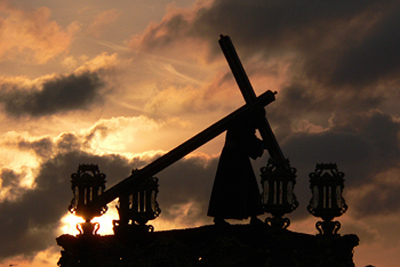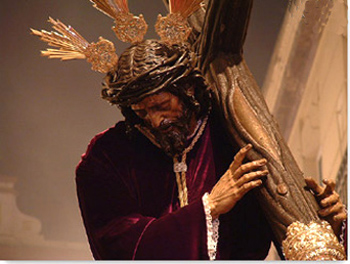Prof. Plinio Corrêa de Oliveira
| One might ask why Our Lord fell three times along the Way of the Cross, and not two or four? I believe there is a reason for the three falls, since everything in Our Lord’s life and Passion had a profound significance. Without pretending to be an exegete, I think that those three falls reveal the three increasing degrees of human exhaustion that Our Lord experienced, which should be meditated upon and serve as models for us.  Holy Week in SevilleWhen one analyzes the legitimate tiredness of a man – I am not considering the vice of weariness of the lazy man because Our Lord had no vice – one can affirm there are three different degrees. In the first degree, a person carrying the weight of the mission placed on his shoulders feels that all his physical strength has been exhausted, and he falls under the burden. Lying on the ground under that weight, he experiences a natural relief and regains a little breath. Afterward, he thinks: “What a heavy load! I cannot lift this load again! However, it is necessary for me to go ahead, and I desire with my whole heart to continue to carry it. I want to take this effort, this act of dedication, to its very end.” So, if he does not give up and wants to continue carrying his burden, he starts to look for any reserve of energy that he did not realize he had in his normal life. He finds some, pulls these unknown energies together to make a new effort, and stands up again. He continues to carry the weight until he reaches the second degree of exhaustion, when he again falls. Weighed down by the heaviness of this second phase of weariness, he thinks: “I have used every bit of strength that I had, and now I lie prostrate as a result of this enormous fatigue. My last energies have been exhausted. Notwithstanding, I want to continue.”  Our Lord on the Road to CalvaryHe meditates on the nobility and the sanctity of the goal he pursues, and at the same time he sees the impossibility he faces to continue. He feels discouragement and perplexity. Where will he find the strength to continue to carry the weight his duty imposes? At this stage, he prays and says, “My Mother, help me now or I will not be able to do what is being asked of me.” He searches the depths of his soul for some remnant of strength and finds there is still something left to give. So, assisted by a supernatural strength more than by his own forces, he stands up again. For the second time, he rises from his fall and continues. He goes on a little surprised because he didn’t realize that he would be able to continue carrying his burden. He drags himself more than he walks, but he goes forward, because he is determined to reach the end. With this conviction he advances further. Then he falls for the third time, which represents the third degree of exhaustion. He is immersed in misery, he feels himself drained, like an empty sack, with not even a drop of energy left. But he perseveres. He looks within himself and thinks: “I still can hope against all hope.” Motivated more by moral perseverance than physical strength, he stands up but is unable to take another step. It is the moment of blind confidence, the dark night, the total immolation. He gives the last breath of his soul. At the same time he has the most lucid vision of his ideal and makes the fullest act of his love. He has given himself completely. He is ready to be crucified. When Our Lord reached this third stage, God sent Simon of Cyrene to carry His Cross, because He could no longer bear its weight. These are the three stages of exhaustion and the three stages of human dedication. He had passed through His complete interior immolationInsofar as a man conquers himself rising from his successive falls, he shines with new degrees of moral beauty. It is the beauty of abnegation that attracts others. When the soul reaches the ultimate limit of dedication, when he has given everything he could give, then he is prepared to attract many other souls to himself. For this reason, after Our Lord traveled the Way of the Cross, He was prepared to be seen on the Cross by all the peoples of History and attract them. He had passed through His complete interior immolation. When Our Lord was crucified, the part of the sacrifice that depended on His will ended. Then, the more sublime and atrocious part of the sacrifice would commence, during which He would suffer increasingly more. But that action of carrying His Cross had ended. Thenceforth, He lay down on the Cross and the Cross carried Him; He no longer carried it. In our spiritual lives, we must carry our crosses. Our Lord wants us to bear our sufferings on our shoulders, to take the initiative and walk toward the complete, sorrowful, tragic and terrible renunciation that we are called to pass through in order to accomplish our mission. After we give the proof of consuming all our energies in order to reach that goal, after we are in a stage of complete exhaustion, then He sends someone to help us walk the rest of our way and He allows us to be crucified in the fulfillment of our duty. We become identified with that burden forever. Our combat is ended, and we win our glory – as He did. Disclaimer: We are not responsible for the content of externally-linked web pages. We do not necessarily endorse the content linked, unless this is explicitly stated. When linked content is endorsed by Our Lady of the Lilies, this endorsement does not necessarily extend to everything expressed by the organization, entity, editor, or author of said content. Fair Use Notice: This web site may contain copyrighted material the use of which may not always have been specifically authorized by the copyright owner. We are making such material available in our efforts to advance understanding of political, human, religious, and social issues. We believe this constitutes a ‘fair use’ of any such copyrighted material as provided for in section 107 of the U.S. Copyright Law. For more information go to http://www.law.cornell.edu/uscode/17/107.shtml. If you wish to use copyrighted material from this site for purposes of your own that go beyond ‘fair use’, you must obtain permission from the copyright owner. |
